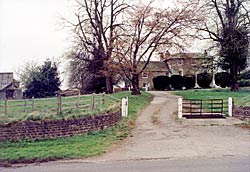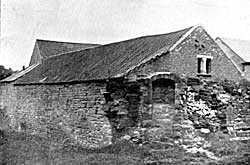
Greasley Castle Farm dates from the 18th century: the outbuildings on the extreme left contain fragments of medieval masonry. (A. Nicholson, © 2003).
Although apparently no record of the architectural features of Greasley Castle has come down to us, there is a considerable amount of information with regard to Nicholas de Cantelupe. It would be possible to reconstruct from the material available1 a fairly detailed life of Nicholas, but even if time allowed, this would scarcely come within the scope of this paper. The purpose of this second section is to seek answers to a number of interesting questions which arise in the history of Greasley, and to use the details of the activities of its builder to illustrate certain well-defined features of the time of Edward III.
Of the lands which Nicholas de Cantelupe held, the most important to us, apart from Greasley itself, was the manor of Ilkeston in the neighbouring county of Derbyshire. Ilkeston and Greasley came into the same hands through the marriage of Sir Ralph de Greasley with Isobel2 the heiress of the Muskham family of Ilkeston. Three generations later Eustachia, heiress of the lands in Greasley and Ilkeston, became the wife of Nicholas de Cantelupe (not the Nicholas who fortified Greasley Castle), thus bringing to Greasley the branch of a family which had already achieved distinction. This Nicholas de Cantelupe was a younger son of William de Cantelupe, Baron Cantelupe by tenure, Senechal to King John.3 Two members of the family had been eminent dignitaries of the Church; Walter de Cantelupe, Bishop of Worcester, and Thomas de Cantelupe, who after being Lord Chancellor, became Bishop of Hereford.4 It was no insignificant family that became connected with Greasley by the marriage of Eustachia. From this marriage came William de Cantelupe who was born and baptised in Lenton Priory in 1263.5 In 1294 he served in Gascony and later in Scotland. In 1299, he was raised to the peerage as Baron Cantelupe by writ of summons. When in 1308 he died, he left a son, also William de Cantelupe, aged sixteen years, and a younger son Nicholas, the builder of Greasley Castle and of Beauvale Charterhouse. Nicholas took possession of the manor of Greasley in 1320 before his brother died,6 although William retained in his own hands other lands of which Ilkeston was part.
From the Inquisitiones Post Mortem (“Inquisitiones Post Mortem relating to Nottinghamshire”); (Thoroton Society Records Series 1914, Vol. II, 1279-1321) it is possible to glean a number of details of the manor of Greasley which came into the possession of Nicholas. On the death of Hugh (c. 43-45 Henry III.) grandfather of Eustachia mentioned above, the jury declared upon their oath7 that Hugh held the manor by the service of a knight's fee to be done to the lord the king. In the manor there were three carucates of land with a capital messuage, together worth six pounds yearly; sixty oxgangs of land in villeinage; free tenants rendering yearly forty-three shillings and ninepence, one pound of pepper and one pound of cummin (a spice); and 14 coterelli who each rendered yearly twelve pence. Other features of the manor were a windmill rendering two marks, a dovehouse worth two shillings yearly and a pasture protected by a wood. A document of 1305-68 concerning William de Cantelupe gives us the additional information that the manor of Greasley was of the great fee of Peveril and held by William “by homage doing suit at the court of the Honor of the liberty of Peverel every three weeks when scutage runs and it is put at forty shillings.”9 This is confirmed by the finding of the jury whose task it was to enquire whether the desire of William de Cantelupe to enfeoff his brother Nicholas of the manor of Greasley would be to the damage or prejudice of the king.

Outbuildings at Greasley Castle Farm in the early 20th century, showing fragments of medieval masonry.
The capital messuage mentioned in the previous paragraph was probably the manor house which Nicholas turned into a fortified manor house in the reign of Edward III. Why did Nicholas wish to fortify his house and why was he given permission? These are parts of a wider question, for during the reign of Edward III. no fewer than 17510 royal licences to crenellate were granted. The number for the period 1256 to 1478 is 371, showing that 47.1 per cent, were granted during the reign of Edward III., an exceptional percentage even when allowance is made for the length of the reign. This high figure is probably due to the prevalent unrest during the period of the Hundred Years’ War, especially in the North of England, where Scottish raids were constant. Defence against possible invasion would have been a good ostensible cause in most cases. There was also, however, the unsafe state of the country illustrated by numerous petitions on the rolls of Parliament and by statutory legislation.11 The numerous commissions of Oyer and Terminer to which Nicholas himself was appointed are useful illustrations of the state of England. In July of 1340 he was sent into Leicester to enquire into the attack upon the chief justice; in December of the same year he was sent to enquire into unlawful assemblies in Lincolnshire; and the next month he was under orders for Lincolnshire again, this time to enquire into murders which had taken place there.12 There is little wonder that, early in the 14th century cathedral and similar closes were fortified; and there was equally good reason for the fortification of country houses.
There is a strong temptation to see in the crenellation of Greasley an additional motive. The foundation of Beauvale Charterhouse so near to Greasley, and so soon after the granting of the licence to crenellate, seems to suggest that Nicholas had social position in mind and was aping the great Norman barons. Roger de Busli had built himself a castle at Tickhill and founded a monastery at Blyth; Henry de Ferrers had built both castle and monastery at Tutbury; and at Nottingham, the castle built for the king, but placed in the keeping of William Peverel, was followed some forty or fifty years later by the Peverel foundation of Lenton Priory, little more than a mile away.
Applications for licence to crenellate were made in Chancery, and the licences were issued in the form of letters patent for which the applicant paid a fine. Probably the charge was determined by what the applicant was likely or willing to pay, and bore little relation to what he intended to do, whether to build what was in effect a castle, or merely to strengthen a manor house with battlements. It would appear that in most cases the licence was simply a matter of business between the applicant and Chancery, and that it went out under the great seal without necessarily coming before the king in person. It is doubtful whether applications were often refused; the Chancellor would be the judge of the applicant’s respectability and intentions. It would probably be a mistake to regard these things as a personal arrangement between monarch and subject.13
Had the permission to crenellate Greasley been dependent upon royal favour, there is every reason to believe that it would still have been granted, for Nicholas de Cantelupe was a man useful in many ways to Edward III. It has already been mentioned that Nicholas was called upon to serve upon numerous Commissions of Oyer and Terminer. But it was not in this sphere alone that he rendered valuable assistance to the king. In 1320 he was in Scotland with Edward II. who six years later knighted him. Early in the reign of Edward III., Nicholas was again in Scotland and in 1336 was made Governor of Berwick-on-Tweed. The year 1339 saw him in both Scotland and Flanders. In 1341 he was called upon to take forty men-at-arms to fight against the Scots,14 and in 1343 he was one of the ambassadors sent to treat for peace with France. At the beginning of the campaign which ended at Crecy, Nicholas was summoned to attend the king. When a French invasion threatened in 1352 he was appointed one of the commissioners for the defence of Lincolnshire. In addition to his services as a soldier he was called to attend Parliament between the years 1337 and 1354. By the time of his death in 1355 he had founded the Carthusian monastery of Beauvale, and Cantelupe College, a college of priests to celebrate at the altar of St. Nicholas in the cathedral of Lincoln.15
(1) See Calendar
of Patent Rolls, Edward III., and Calendar of
Close Rolls, Edward III.
(2) Thoroton: Throsby’s edition, Vol. II, pp. 239-246. Throsby
gives a different descent based upon Rastall, and Dugdale’s extract from
the Beauvale Register. Thoroton with a fully documented description,
seems preferable to Dugdale, full of pitfalls for the unwary. See also
Griseleia, Baron von Hube, p. 7.
(3) History of the Parish and Priory of Lenton, Godfrey, p. 130.
(4) A History of Nottinghamshire, Cornelius Brown, 189(5, p.
241.
(5) History of the Parish and Priory of Lenton: Godfrey, pp.
130-31n.
(6) Inquisitiones Post Mortem relating to Nottinghamshire,
Thoroton Society Records Series, 1914, Vol. II, 1279-1321, p. 302. On p. 257
of “Notes on the churches of Derbyshire” by J. C. Cox, 1879, Vol. IV.,
there is the suggestion that William and Nicholas were father and son,
but the Inquisition mentioned above makes it clear that they were brothers.
(7) Inquisitiones Post Mortem relating to Notts., Vol. II, pp.
137-8.
(8) Ibid., p. 213.
(9) Ibid., p. 302.
(10) These figures are based on the table of Royal Licences to crenel-late
given in The English Archaeologist's Handbook, Godwin, 1867. Stubbs
Constitutional History of England, Vol. III., p. 537, gives 180 as
the figure for the reign of Edward III.
(11) Professor A. Hamilton Thompson.
(12) Calendar of Patent Rolls and Calendar of Close Rolls for
many others.
(13) Professor A. Hamilton Thompson.
(14) Rymer, Vol. V., p. 290. Edward III. sometimes raised troops by
Commissions of Array but more often by agreement with well known captains
who raised, organised and led a number of men. (See Oman: History of
the Art of War, p. 591 and England in the Later Middle Ages, Vickers,
p. 224). This may be an example of the second method.(15) Dictionary of National Biography, Vol. VIII., p. 447.
